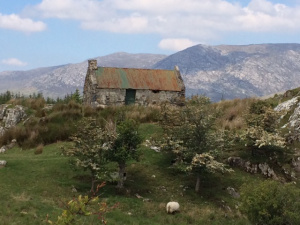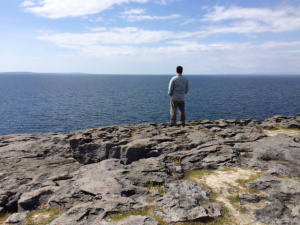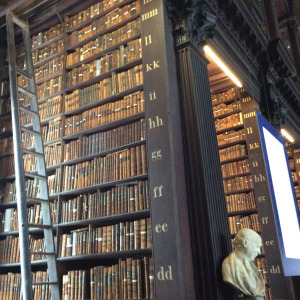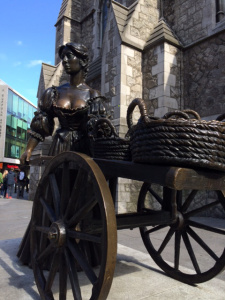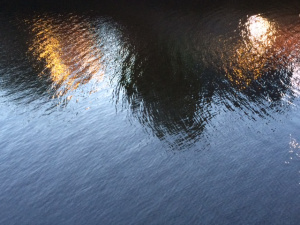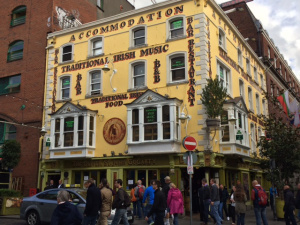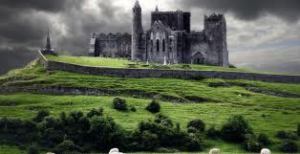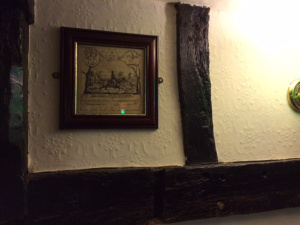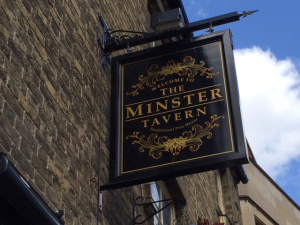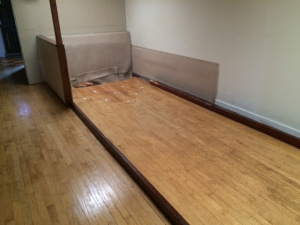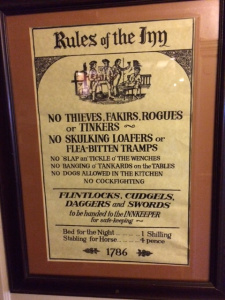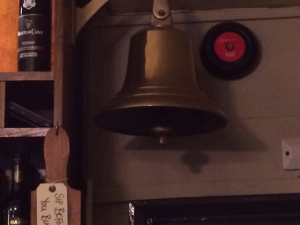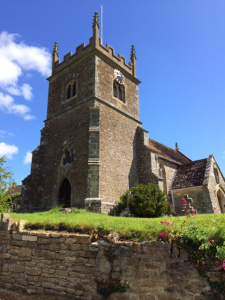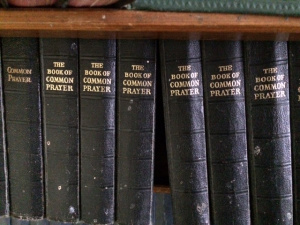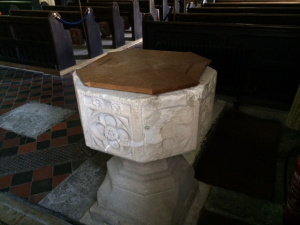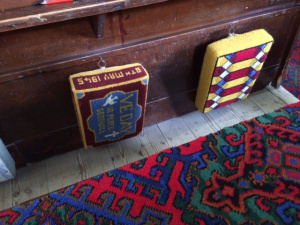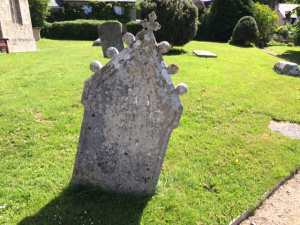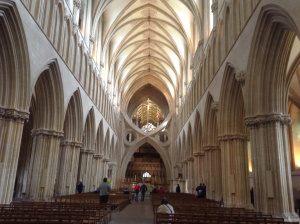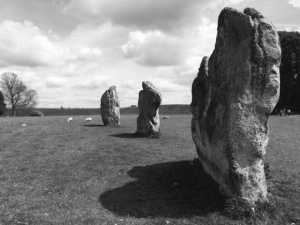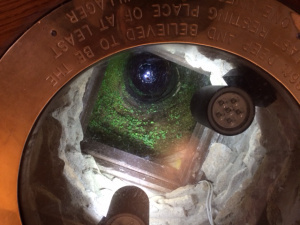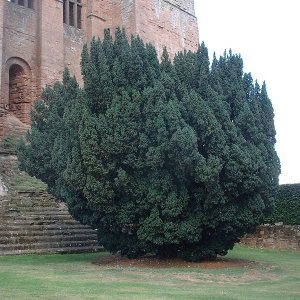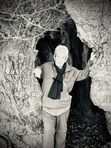Patrick Egan's Blog, page 48
June 12, 2015
The Silent Songs of the Burrens and the Rebel Songs of Galway
 I stood at the edge of the famous Cliffs of Moher. Just a short drive from Shannon Airport, this site is one of the first stops for tourists. The last time I stood at this edge of Ireland where the Atlantic Ocean pounds silently far below us, at the base of rock faces that can cause you to miss a breath, I couldn’t see anything. It was misty and a wet wind nearly blew me over.
I stood at the edge of the famous Cliffs of Moher. Just a short drive from Shannon Airport, this site is one of the first stops for tourists. The last time I stood at this edge of Ireland where the Atlantic Ocean pounds silently far below us, at the base of rock faces that can cause you to miss a breath, I couldn’t see anything. It was misty and a wet wind nearly blew me over.
Not today. We had just picked up my son, Brian, and the weather was clear enough so when you looked out to the ocean, you could see the curvature of the earth. A harpist played New Age Celtic melodies for the crowds that were trudging up the steps for the best view. A fiddler played. A man on a penny whistle played. The music blended nicely with the quiet view. We were too far above the waves to hear any crashing surf. The music was the soft lilts and airs of this land of music and dance.
I watched my son. He leaned against the great stone slabs that protected oblivious tourists from getting too close to the edge. I saw him close his eyes briefly. He heard the music of the sea without hearing the sound of the water, so far below.
Our destination for the night was Galway. Another few hours of driving would put us at a B & B in Salthill, just a short walk to the famous Latin Quarter. We were going in search of pubs that played traditional Irish music.
But first, we had to drive through the Burren. This is a strange place indeed. Lunar-like in its landscape, it is where many people get their first real look at the wild and isolated regions of Ireland. Unless you’re mentally prepared, there came be something unsettling and odd in this land of flat limestone. In the full sunlight, the stone can be nearly blinding with its white-gray surface…a surface that give you the sense that you can just turn your car to one side and just drive over the pavement.
But that would be a bad idea. It was rolling and full of boulders and fissures in the rock that are a foot wide. I parked the car to stretch and I walked away from the road. It was silent, save for the wind in my hair and blowing through the heather patches and wildflowers that found a home in the cracks.
I heard something. I heard music. I looked around and I was too far from any car for a radio to be heard. My wife and son had found a nice place to sit and wait for me.
There it was again. I heard music…it was an ancient air…a mournful tune…a lament that came from the very rocks I was standing on. I heard familiar melodies like Molly Malone and . I heard the music of an older time when life was simpler and more gentle. A time when God may have been present among the lives of men. A time when nature herself ruled the earth as the Mother Goddess in the times of the Mist. I heard the songs of the fossils that were older than time itself. The shells and the oolites of the limestone was alive with something I couldn’t understand or touch.
Just listen.
I walked slowly back to the car, afraid to confront reality. That’s when I saw my son standing and looking out over Galway Bay. I wondered if he heard the music as I did. I walked up and stood beside him.
“This is insane,” he said.
I knew what he meant. I think it was his Gen X way of saying: “I get this place right now. I really do.”
We drove on. Cottages, bonded to the solitary sheep, began to appear as if to announce that humans still used this land.
Then, the flatness returned. The rocks stretched toward the Bay and then, with a ninety degree drop, met the water.
We stopped a few more times before we left the Burren. Brian got out of the car once more and walked to the edge once again. He looked out at the water.
I tried to read his mind, but couldn’t. And, that’s the way it should be.
That night we went to the Latin Quarter in Galway, not very far from the Spanish Arch. We heard music again. Finnegan’s Wake, Raglan Road, The Wild Rover. Songs of the people. Songs of the struggles. Songs of unrequited love.
Songs that define this ancient and complex island.
Songs that were sung for a hundred years…perhaps by people who had my blood in their veins.
drove to Galway and stayed at a B & B in Salthill less than a mile out of the town center. (I never got a post out last night because the WiFi was very weak and I was exhausted from the driving).
We found a street in Galway that was as lively as anything I’ve seen in Paris. Dozens of pubs and restaurants. We had dinner and found several pubs that played Irish music until quite late. I think I’ve heard The Wild Rover at least ten times yesterday. Brian loved the music and was getting into the spirit that infects those yanks who find themselves sitting a real Irish pub…in Ireland…and not one called The Shamrock on E. 71st. in NYC.



June 9, 2015
The Swans Of The Shannon River: Limerick On A Warm Afternoon
I dropped Mariam at our hotel and drove off to find the parking lot. I made two lefts and passed two pubs, one of which was called The Sin Bin. I took note of the name. Maybe this pub had something more than pints of Guinness. I walked back to the hotel and we decided to walk along O’Connell Street. In two blocks it turned into Patrick Street. Limerick wasn’t fine and healthy in this part of town. There were a fair number of boarded up storefronts and more than the usual number of Asian restaurants. Only a few old-fashioned pubs hugged the sidewalk…and they looked nearly closed. They had none of the classic “Irish Pub” look so many places in London, Dublin and even New York sported.
It was an unusually warm day for the west of Ireland. Temperatures must have been in the low 80’s F. We walked down to the quay that ran along the Shannon River. I looked across the water and was surprised to get a fine view of King John’s Castle. I had driven past the place many decades ago and the place still gave me the chills…even in the June warmth.
Yes, this is the same King John who signed the Magna Carta in 1215 in a field near Windsor, England. He was the youngest of five sons of Henry II and Elenore of Aquitaine. (That would be Katherine Hepburn in the movie.) He was given lands in France and England and Ireland. He became known as the Lord of Ireland and ordered this castle built in 1200.
Before the English arrived, the Vikings had a walled town here on or about 922.
But today I was watching a bevy of swans fighting for food that some guy was throwing down from the walkway. A feeding frenzy of swans is quite a sight to see since swans seem to me anyway, a symbol of calmness and grace.
This city of Limerick showed signs of a past glory. That past is coming slowly back to live through various civic projects. It’s a beautiful Georgian town, like Bath in England, but without the funds to fully restore the townhouses and old cemeteries. But things are happening. I hope the progress continues. After all, the city got a bad reputation as a result of Frank McCourt’s Angela’s Ashes. Many of the locals were angry, so I’ve read, at McCourt at presenting a depressing and dismal part of the city’s history.
But, the swans looked happy and uncaring. What more could they want? It was warm and it wasn’t raining.
I’ll settle in to read now. My son will be at Shannon Airport at 11:00 am in the morning.
He’ll see the landscape of the Burrens and Connemara for the first time, just like I did thirty-one years ago.


June 8, 2015
Crossing The Liffey: Our First And Last Full Day In Dublin’s Fair City
I was sitting opposite my wife in the restaurant of the Arlington Hotel where we are staying. It’s just steps away from the O’Connell Street Bridge. I was making strange, odd and contorted…some would say ugly faces in her direction.
She simply stared back at me.
My eyes watered and I continued to wiggle my face into creepy shapes. She must have been thinking I was making faces at her, but she simply stared back at me. I managed to make a comment.
“Funny what air-borne pepper can do to the inside of one’s nose,” I said. I had just peppered my Irish Stew and the mashed potatoes that sat on the plate begging for a hit of pepper.
The sneeze, when it finally came, is something I’d rather not talk about since I had a small bit of stew at the back of my throat in the last stage of a swallow.
Like I said, I’d rather not talk about it.
I’d rather tell you how we had spent most of our one and only full day in this most unusual city. The weather was cool, enough so to give me an excuse to buy an Irish tweed cap that I wore proudly the rest of the day. I would have walked among the crowds as a local, a native, a true Dubliner, a real Irishman if it wasn’t for the Nikon D3200 DSL (red) around my neck.
We were exploring the section of the city called Temple Bar. It’s across the Liffey from our hotel and it’s a very hip place indeed. The focal point of Temple Bar is Trinity College where the famous Book of Kells is on display. I’ll get back to that.
We were passing a theater and there was a small queue at the door. I saw a young woman sitting on a step so I asked what she was waiting for. She gave the name of a band that I had never heard about. I was fixated on her forehead (for a change) and pushed the conversation a bit.
My wife waited patiently across the street.
“Do you know the area well?” I asked.
“No, I don’t actually live here. What are you looking for?”
I had been thinking of the great poem “Raglan Road” by Patrick Kavanagh. I know it best as one of my favorite Van Morrison songs from the Irish Heartbeat album that Morrison recorded with the Chieftains sometime in the mid 1980’s.
The poem is a tragic and heartbreaking lament of a man falling in love with a stranger. A dark-haired woman. The narrator knew somehow that “her dark hair would weave a snare that one day he would rue.”
He meets her on Grafton Street in November. And, as in most Irish poems and songs, the love is unrequited. At the end of the poem he sees her:
On a quiet street where old ghosts meet I see her walking now
Away from me so hurriedly my reason must allow…
I told the young woman I was looking for Grafton Street. She knew where it was.
“Just go straight on until you see Trinity College and it’s just there.”
I thanked her. Her name is Jessica. She is beautiful and her forehead is quite fabulous.
We continued on toward Trinity College. We were intent on seeing the Book of Kells. A woman in our hotel lobby told me earlier that the lines are crazy and to “book online”. But, we were at the admission desk of the Library and there were no lines. We paid our fees and before we could say “calligraphy”, we were looking into the glass case containing, arguably, one of the most famous books in Western Civilization. When they were burning women as witches in England, the scribes and artists of Ireland were copying this most impressive Illuminated Manuscript I’ve ever gazed upon. I couldn’t even sneak a photo on my iPhone so you’ll have to Google it to get a sense of the fierce beauty of the page.
We then went into the Long Room of the Library. Now, I love books…anyone who knows me is aware of that, so when I entered the main room, I nearly wept at the sheer number of volumes that are neatly stacked at least three stories high.
[This is only one of more than forty book stacks]
We stopped into one of the many pubs near the college for a bit of a rest. When we emerged, we were only steps from a small intersection where the statue of Molly Malone was erected in 1988..
I looked at her sad face and her fish-monger wares and then leaned against a wall and thought of the few lines of the song that I could remember:
In Dublin’s fair city, where the girls are so pretty
I first set my eyes on sweet Molly Malone
As she wheeled her wheel barrow
Through streets broad and narrow
Crying ‘cockles and mussels alive a-live O!
Many tourists were crowded around to get the best angle. She is cast in bronze and her plunging neckline reveals an ample bosom with cleavage to spare. An Italian man climbed on the pedestal, and, in full view of the crowds, proceeded to put his hands on her bosom. After he climbed down, I looked at the breasts of Molly Malone. They were quite polished by the touch of many hands.
Honestly, men have only one thing on their mind. Have they no shame? I kept looking back at her chest and wondering why men are such crude blokes…when I nearly fell over a trash can. I moved on to our final crossing of the Liffey.
We arrived at the far side of the O’Connell Bridge. I didn’t want to go back to our room yet. I wanted to soak in Dublin “in this fair old time.” I hesitated beneath a lamp-post.
I looked into the waters of the Liffey and saw the reflections of the lights of our hotel on the far side. I saw the reflections. I felt the history. I smelled the air. I let the noise of the taxis and buses and chatting couples fill my ears.
When would I come here again? When would I cross the O’Connell Bridge and look for that elusive white horse of legends?
June 7, 2015
Dublin On A Sunday Afternoon
It was a brief flight. Heathrow to Dublin airport in a little over an hour. No time for a movie. No time for any real food. I looked across Mariam’s lap and watched the fields of Wales slide under us at several hundred miles per hour. Still, when we landed and took the taxi to our hotel, we felt the need to take a walk.
I hadn’t been in this curious city in thirty years. I wonder why it took so long to return. Was I avoiding something? Like memories that were so pleasant that I didn’t want to shatter them with fresh images? I wanted to keep thinking of this place as a cracked photo yellowed with time and not a memory made of pixels. We walked to O’Connell Street and took a left. A block and a half and we were standing in front of the General Post Office, still showing bullet holes from the Rising of 1916 when the English shelled it from a gunboat on the River Liffey.
We walked to the famous Abbey Theater where the cream of the English thespians trod the boards.
Then we crossed the O’Connell Street Bridge. In my mind, nearly as famous and important as the Tower Bridge in London. There is a legend that states that you will always see a white horse when you cross the bridge. Another legend says you will see an Irish prostitute if there is no horse.
We saw neither (as far as I knew…I know a white horse when I see one). One wonders what will become of your day if you saw both. Or, even more ideal, a prostitute riding a white horse. But I’ll save that story for another day and another blog.
We went a block into the section called Temple Bar. It’s just opposite our hotel. There were more pubs that one could easily count. But the Garda (police), in their yellow vests, vastly out numbered the pubs. It seemed like there had just been an upgrade in the terrorist rating…but it was more to do with the rowdiness of the drinkers than any bombs. One Garda was riding a white horse. I stopped to consider this.
I found a pub to rest in. They were playing some traditional Irish music. We sat for a bit and listened. I took a photo of a pretty bar maid. She seemed pleased someone noticed her behind the stack of empty pint glasses she carried.
The Irish are an attractive people.
Doubling back to the Liffey, we crossed the Ha’penny Bridge. Small pad locks were beginning to collect on the metal bars of the railings.
Paris just recently dealt with the thousands of locks on the Ponts over the Seine…they simply cut them off. Would this be the destiny of the Ha’penny locks? Who placed the very first lock? I wondered about this and lost myself in thoughts about whether they were still together or had they separated and left only a small chunk of metal or brass to rattle in the winter wind and signify nothing.
After dinner and a show of Irish dancing (think Riverdance with four dancers) we went back to the O’Connell Street bridge.
One would never guess it was a Sunday night.
I stood on the bridge and read a small plaque about a man whose carriage plunged into the Liffey at that spot. I thought of ghosts. Was the bridge haunted?
Was the bridge haunted by this poor drowned soul, or a thousand prostitutes…or a hundred white horses?


June 6, 2015
May The Sun Rise To Meet Him
On Wednesday, my son, Brian will step off the red-eye flight from JFK and the sun will rise to meet him. I will have my son, my boy, my only boy with me while we tour our ancestral island with my wife (on her first visit, too).
It’s been thirty years since I’ve been to Ireland. I can hardly wait to see how it’s changed, fear how it’s changed and hope that some things are not changed at all.
I will take Brian to see some Irish Egans. I will meet a distant cousin I haven’t seen since 1984. Together we will visit the graves of my other relatives who have passed on in those past three decades. As homework, I asked him to watch The Quiet Man, something I’m sure he didn’t have the time to do. That’s okay. He has me as his guide.
I will be the Seanchai, and tell him stories of Irish history…the glorious tales of heroic myths like Cúchulainn and Tir Na Nog and Brian Boru.
I will also tell him of the days of the famine, when the British landowners shipped beef and potatoes back to England, leaving the Irish to eat dirt.
He will hear of the Uprisings. He will hear of Kevin Barry, a man younger than my son, who was executed by the English in 1920. He will know of Bobby Sands and the hunger strike that took his life six years before my son was born.
[I love England, as my readers know, but I also understand what some English did to my people.]
I will show him the Cliffs of Moher, and the towns of Galway and Sligo.
I will read Yeats to him under bare Ben Bulben. I will make every attempt to get him a sip of Potcheen. Like a true Irishman, I will talk his ear off while he is cornered in a pub in Culleens.
We will walk among the ruins of Cashel and rub our hands against the ancient rock. The lichen and the moss will scratch our palms. It’s likely to rain Irish water from Irish clouds on his shoulders. The fog may slow our driving through the narrow lanes. But, in the few days he has to be with us, I will touch the highlights that will dirty his fingers with the soil of his homeland.


If Hand-Hewn Beams Could Talk: A Proper English Pub
I’ll repeat what I said in a previous post:
“If you want to know what is happening in an English village, just sit in the pub for an hour or two.” I am convinced that this is true. Pubs and not bars in the way we know bars in the States. If the village is small enough, nearly everyone who lives nearby will stop in for a pint, a dinner or a quick chat. It’s the way the social network works in this little country.
I’ve been in quite a few pubs during my time here. As many of you know, I lived in Dorset for a year and have returned to see old friends and visit old haunts in 2012, 2014 and this year. I seem to gravitate to Dorset because there is something about the ancient footpaths, hedgerows and pubs that have made their way into the core of my being. In my second book, “An American in Dorset”, I try to explain my feelings. I’m not sure I can fully describe how the wind blowing through a field of rape or an ancient copse of oaks hides secrets or how an ancient tumuli holds the bones of someone who walked the fields and tended sheep while the Egyptians were building the pyramids.
As I’ve tried to give you, my faithful reader, a look at a small English church, I will take you into a typical pub and make a humble attempt to give you the feel and the experience.
My photo gallery:
[Most pub signs are decorative, clever, artistic and usually relate to something local…though not always. Common themes are Kings, Queens, Harts, Arms, it goes on and on. My personal favorite is the pub I spent a great deal (in the year I lived in Dorset, 1984-85), of time having dinner and sipping my Best Bitter is the Barley Mow]
[There is usually a cozy place to sit beside the fireplace.]
[I would say that it’s a rare pub that does not have at least one TV so you can keep up with the Leeds football game with Liverpool.]
[Other than the ever-present dart board (failed to get a photo, sorry mate), there is often a Skittles game in the rear of the pub. It’s a bowling sort of game.]
[A great selection of beers is found in most pubs…and sometimes a pretty barmaid to serve it to you.]
[Many pubs have charming posters…here’s one.]
[And another.]
[Here is the desert menu. Third from the bottom??? Don’t ask.]
[Yes, I took a photo in the Gents room to illustrate the communal nature of the urinal. These are not found as often as they once were. But, at least you had someone to talk to while you went. Remember: you don’t “buy” beer, you “rent” it.]
[And, at the hour that all men dread…it used to be 11:00 pm for decades…the pub owner would ring a bell (at 10:50 pm) and say rather loudly: “last call!”. Then at 11:00 pm sharp, the bell would ring again with the age old…”Time, gentlemen, please.”
I loved the culture and atmosphere of the English pub, from the Duke of Wellington in London to the Horned Ram in Puddletown. There is a long and lovely history of uncountable lives that played out in the pubs of England.
This is my final post from England. Tomorrow, we fly to Dublin, Ireland and spend eight days in the country where people walk and work and drink…that have my very own blood in their veins.
Tomorrow I’m going home.
June 4, 2015
I Never Met An English Country Church I Didn’t Like
[St. John the Baptist, Buckthorn Weston, Dorset]
It’s been said by many travelers that if one wants to know what’s happening in any small English village, just go to the pub and listen for an hour. I think the same is true, to a degree, of social life provided by the Church in these towns and hamlets that appear on maps as small squares with crosses.
The village names themselves are worthy of a post for their own sake. There’s Guy’s Marsh, Ebbesbourne Wake, Bowerchalke, Broad Chalke, Sutton Mandeville, Donhead St. Mary, Mellbury Abbas and (my favorite), Little Puddle Bottom. And, that’s just the tip of the iceberg when you consider the English penchant for descriptive and proper geographic place names.
Each of these towns, each of these dots and intersections on maps, nearly always contain a church. The vast majority of these are Anglican or Church of England. Americans know them as Episcopalians. One drives by these small churches everyday when you’re motoring about from places like London to Stonehenge. Stop in one of these small buildings, and time has stood still. Each one is different yet each one is nearly a carbon-copy of the next.
You enter the church grounds (if you’re lucky) through a lychgate. These are small entries into the churchyard that have a roof to protect the pall bearers from the frequent rains. Here, the mourners and the coffin await the priest to emerge and begin the funeral service.
Once inside, you feel the chill. I didn’t have my pocket thermometer with me, but the churches I visited today probably were all about 56 F. If I were attending service, I would hope for a highly charged sermon full of fire and brimstone.
I’d feel warmer.
Here is a small photo gallery of the common sights one sees in so many of these lovely and ancient structures. And, by ancient, I really mean ancient. Most of the churches we visited on June 3, date back 800 to 1,000 years. It staggers the mind to contemplate the fact that worshippers offered up their prayers and pleas to that many years. These churches were ancient centuries before Columbus even thought of sailing to the edge of the known world.
Here are some photos:
[Typical lychgate]
[The Book of Common Prayer for the congregation]
[The effigy of Alexander Mowbray who died in 1410]
[Baptismal font from the late 1300’s. I find it interesting to contemplate the tiny infant being baptized and then, 80+ years later, ending up in the ground outside the church under a stone encrusted with moss and lichen.]
[Cushions for kneeling. Sometimes made by the local ladies. Many are Regimental Insignias]
[From birth to death. The end of the story for the faithful worshippers]
The first stanza of one of my favorite poems:
“The curfew tolls the knell of parting day,
the shepherd, homeward, plods his weary way,
the lowing herd wanders slowly or’ the lea,
and leaves the world to darkness, and to me.”
–Gray’s Elegy Written in a Country Churchyard.


May 31, 2015
68 Steps Along The Nave Of Wells Cathedral
Three hundred and sixty-five days ago, I was climbing the endless steps of Sacre Coeur in Paris. My wife was at my side. We paused on the 67th step, and, in the warm Parisian sun, we turned and looked back at the City of Lights. We kissed on that 67th step.
It was my 67th birthday.
Today, I am 68 years old and we are sitting in a cafe in Wells, England. This is in the county of Somerset. I think that’s a beautiful name…Somerset.
A few minutes ago we walked down the middle aisle of the nave of the Cathedral. We were approaching the great arches that somehow set this Cathedral apart from the other massive Gothic buildings we’ve seen.
I looked up at the simple vaulting on the ceiling. At my feet were large slabs of marble that marked and described the dead who are buried beneath the church. Organ music played quietly and with a simplicity that reflected the architecture. This place totally lacked the high grandeur of a Westminster Abbey.
We paused—68 steps along the nave. We happened to be standing on the grave of a married couple, dead now for centuries. They would rest beneath the floor until the Cathedral walls crumbled to the ground.
I turned and kissed my wife.
We would be together until the stones of our lives crumble.
I wonder where we will kiss when I turn 69 years old in 2016.


The Haunted Well Of Avebury
I heard about the haunted pub and the cursed well of Avebury while touring a church in Gloucestershire.
I was purchasing a CD of Traditional Country Songs (sung by a small chorus) at the gift shop of St. John the Baptist in Cirencester. I recognized many of the titles from my collection of Irish songs and I was curious as to how it would sound by a choral group. I paid my £12.00. I noticed from a lapel tag that the man behind the gift table was a chap named Jonathan.
“Don’t you think this is a beautiful space?” he asked.
“Well,” I said, “its beautiful enough and large enough to be an Abbey.”
“Have you seen the Green Man? We have a Green Man here…if you know where to look.”
Being a fan of Green Man legends and mythologies and I was surprised that I had missed the carving of a face with branches growing out of eye sockets, the nose and the eyes. Unless this figure was quite hidden or very tiny, I had overlooked a most fascinating detail.
Jonathan locked his cash box and literally leapt from his chair.
“Follow me,” he said. “I think you’ll find this interesting. I worked here a year before anyone mentioned the Green Man and pointed him out to me. Here. Just stand here and look up…straight up.”
I leaned back and picked out the figure on the ceiling in less than a minute. I told him that I found symbols of all kinds of great interest. I look for them on tombstones, along the walls of old churches and in the amazing scenes depicted in stained glass windows.
“Thank you so much,” I said. “I’d love to talk but my wife and I are one our way to visit the stone circles of Avebury so I’ll have to say thanks and good-bye to you, Jonathan. I appreciate you’re taking a few minutes to point the Green Man out to a couple of Yanks.”
“Avebury? You’re going to Avebury? That’s one of my favorite places. So much better than Stonehenge,” said Jonathan, “and you can walk among the stones. Can’t do that at Stonehenge…unless, of course you’re a Druid.”
“Well, they probably would make it difficult to allow me, as a foreign person, to be a Druid,” I said. “Again, I’d love to chat but we need to get on the road. Thanks so much…again.”
I walked toward the large dark wood doors. I was preparing to put on my sunglasses in the bright light when I heard Jonathan say something.
“There’s a haunted well in Avebury, did you know that?”
I stopped in mid step and spun around.
“A haunted well?” I said.
“Yes, and it’s inside a pub. Want to hear the story?”
There is no way that I could say “no” to this fellow. The promise of such a story had great potential.
“Yes, I would like to hear it, Jonathan. I most certainly would like to hear it.”
“Well, it has nothing to do with the stones of the neolithic circles,” he said. “this is how the story goes, at least as I’ve heard it.”
“During the Middle Ages, actually about the year 1500, the village of Avebury was ruled by a Lord of the Manor. Typical in those days. Apparently he had his rheumy old eyes on one of his prettiest milkmaids who worked at one of his farms. She was barely out of puberty. Some have written that she was about fourteen years old. Well, you don’t need a vivid or particularly dirty imagination to figure out what this Manor Lord did with this poor girl. She became pregnant. In those days, women who found themselves in such a situation were almost always blamed for their condition, and her “behavior” was frowned upon by the townspeople.
“The Lord of the Manor? He was untouchable, wasn’t he? No court of law would rule against him…he likely was the law. So, justice was carried out by the mob. They came one night to the girl’s farm and dragged her to the market square. In that square was a deep well. Her fate was sealed. They led her screaming to the edge of the hole and threw the poor soul in. The well has been measured at 87 feet to the water. Can you imagine the terror and the screams from the child as she fell those 87 feet, clutching vainly at the sharp rocks, trying to stop her fall with her bare feet and bleeding knees? After she hit the water, a silence descended on the crowd. The screams stopped. The silence from the bottom of the well was absolute. The torches couldn’t penetrate that deep so the men who looked down could only see inky blackness. And hear the total quiet. It chills my skin to tell you this. But, the well is still there. It’s now been covered by plastic and it is part of a table in the dining area of the pub…how’s that for a story?”
I was transfixed.
“Oh my God, how sad,” was all I could say.
Several hours later we were in the Car Park of Avebury. We walked around the stones. I watched a Druid-like ceremony at one of the standing stones. I kept looking across the field at the pub. It was white, and I think it had a thatched roof.
I simply had to look down the well.
“Let’s have a quick drink and a light sandwich here,” I said to Mariam. She had heard the story as I did and she was as anxious to see the well as I was.
It was crowded with tourists. I went from sitting room to dining room and looked for the well. Finally, I found it in the third dining area I entered. There was a woman sitting at the table sipping a white wine. I apologized and asked if she’d mind if I took a few photos. She said it was no problem.
I told her it was the price she paid to sit at a table built over a haunted well.
I approached the plexiglass cover. I leaned over and looked down. There were lights along the round wall that made small green-leaved and moss seemed to glow. I looked deeper and say the surface of water, 87 feet down. The light in the room lit the bottom of the well and I could see my own reflection in the still water.
I stared, waiting for a small pretty face to look up at me, but none appeared. But, I must admit that I felt a particular unease as I looked down. It was though I was expecting something or someone to speak to me. I could almost hear the girl’s voice. I could almost hear her screams.
But, what I seemed to sense, overwhelmingly, was sadness. Someone was crying inside my head. Someone, through no fault of her own, was violated and murdered. I almost began to cry but my wife pulled me away.
I assume her spirit wanders the village square, the dining room or the stone circles…looking for someone to protect her. I wondered. If I stayed overnight at the pub or a nearby B & B, and I happened to come face to face with a girl dead over six hundred years…what would I say? How could I find a way to break the chain that keeps her spirit linked to the well?
I know I couldn’t. If there is a just God, than He or She must have pity on her lost soul.
I walked back to the car park with a leaden heart.
I also wondered which local churchyard held the grave of our Lord of the Manor who damaged this young girl’s soul for over half a millennia. Is his soul resting in eternal peace? Or does he too wander the lanes and fields trying to find forgiveness?
He does, if there is true justice.
[The haunted pub is the small white building in the right portion of the photo just above the largest upright stone on the right]


May 29, 2015
The Green Man: Watcher Of The Lychgate
I am a conflicting image. Sometimes I appear in churches, carved into the bosses of an archway. At other times, I am associated with pagan symbols of nature worship. I am a man and I am a tree…one part of me morphs into another. I am called The Green Man by those who study the esoteric arts and druidic symbolism.
In this story, I am part of the Yew tree. But, I can be seen in any great mass of foliage. You just have to know where to look for me. And, you have to know how to look for me. Just look deep into the forest or the hedges or the copses of trees…and you may be lucky enough to find me. My history is older than the oldest oak. My story begins at the time in history when stories themselves began. To ward off the fear of the darkness, the common folk would gather around campfires or hearth fires and tell stories of ghosts, lost maidens, valiant knights, beautiful queens and dead kings.
They would tell tales of the Little Folk in Ireland or the fearsome monsters of mountain lakes like Grendel in Beowulf. Uncountable witches, demons and heroes were the threads that held these narratives together.
I am just one of them.
I live in this deadly tree because nearly every part of it is toxic to humans, except the berry. The beautiful bright red berry.
Why am I dwelling in this strange tree of uncountable cemeteries?
My job is to look down at the Lychgate at the entrance to the churchyard and keep account of the joys and sorrows that enter and leave the church.
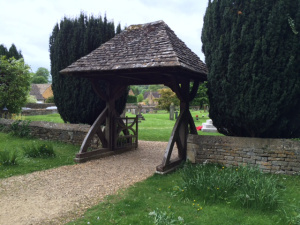
The Lychgate is traditionally the place where the shrouded corpse is kept before the priest can emerge from the church and begin the service of burial. In later years, I protected the pall-bearers from the elements. It seems it always rains on the days of burial.
Maybe not.
The pall bearers would pull their scarves snug around their necks and glance down at the coffin of their friend, their parent, spouse, child or grandparent. They would hold firm to the brass handles.
Inside, the priest secures his heavy cloak and takes a final nip from his flask to warm his tongue and throat.
They all would meet at the Lychgate to begin the prayers. And, who doesn’t need the prayers? After a few minutes, all would walk slowly to the newly dug grave, lower the corpse and say a final prayer. The priest would go back inside to prepare his sermon for Sunday morning. The pall bearers would head to the nearest pub and toast the departed.
The surviving families would go home to mourn and feel the deep emptiness that suddenly is a part of the house.
In time, they will begin to live full lives again–until their turn comes to pass through the Lychgate.
Sometimes, on a bright joyful day of a wedding, the new couple would leave the church door and reach the Lychgate. There would be a rope tied across the opening. The children standing and giggling nearby would have to be paid a few pence to have the rope untied.
I watch over these things. You will never see me in the Yew tree, but I’m there.
Someday, I will find the living people who passed through my Lychgate. I will come to them in their dreams and cause them to remember the day they spent near the gate.
Some will cry real tears of real sorrow. Some will cry real tears of joy.
All these things happen at the Lychgate. I know. I’ve seen it all from my vantage point…hidden in the green foliage of the earth.
Take care what you say and do in the protection of the shady forest, for the trees have eyes and ears.



